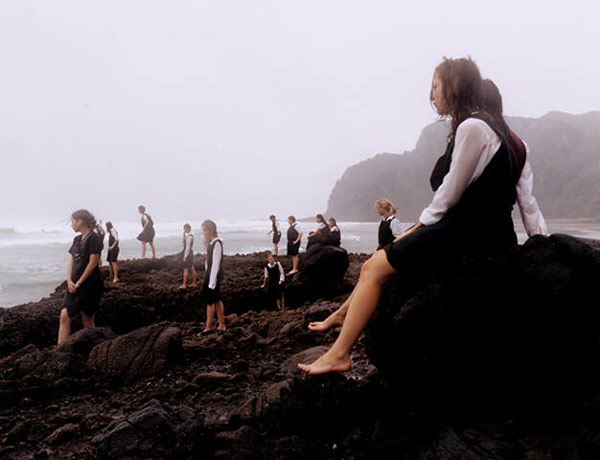Justine Kurland’s subjects are young women nearing adulthood. To this theme, Kurland brings a particular American point of view, photographing her models in roving packs that crisscross and occupy the landscape like she-wolves. Posed in large color tableaus, Kurland’s subjects engage each other in listless occupations in landscapes that, like themselves, seem suspended between two absolutes.
Previously, Kurland’s photographs addressed a particularly American view of adolescence, one founded upon restlessness and the myth of the frontier. In pictures of slumber parties held in gravel quarries and girls camping in roadside marshes, Kurland emphasizes the between state of adolescence by locating her narratives in those uncharted spaces of questionable ownership that edge suburbia. Such places owe their wildness to territorial marginality and, Kurland’s pictures seemed to suggest, represent the only frontier remaining to American teenagers. By placing in this landscape girls who fish, build fires, and climb fences, Kurland countered the traditional view of the frontier as an exclusive male precinct just as she reinforced the myth of female dominion in the natural realm.
Kurland photographed for two months in New Zealand in early 2001 at the invitation of the Auckland Art Gallery. This was the first time she had worked outside of the United States and the circumstances of the commission caused her to modify her methodology. Unable to collaborate with girls she already knew or could meet on the street, Kurland arranged for introductions to girls through the city’s schools. Although Kurland frequently augmented the costumes of her American models to achieve a certain travel-worn adolescent glamour, in New Zealand she chose to photograph her models in their school uniforms rather than in street clothes. In addition, rather than locating the photographs along the urban periphery, Kurland chose semitropical or lush pastoral sites, another critical distinction from her photographs made closer to home.
Iconic references to painting, classical mythology, and nineteenth-century landscape photography, as well as literature and film, can be discovered in many of Kurland’s pictures. In Battlefield, for instance, a picture made at the site of the earliest conflict between the native Maori and the European explorers, Kurland scattered her girls across a field like the many bodies in an Alexander Gardner photograph of the aftermath of the battle at Gettysburg. Similarly, the floating body of a girl in Eel Swamp references Sir John Everett Millais’s painting Ophelia (1851- 52), while the more portentous pictures of regimented group behavior suggest the dark theme of social disintegration found in William Golding’s seminal novel Lord of the Flies. In photographs made in both America and New Zealand, such references reinforce the allegorical impulse and dramatic effect of Kurland’s pictures.
In discussing her trip to New Zealand, Kurland describes how the blend of Maori and European civilizations is made manifest today through dress and manner. Significantly, in her New Zealand photographs, adolescent girls are no longer cast as members of a closed society, but, through their uniforms, are made emblematic of the country’s colonial history. The girls in Kurland’s photographs move trance-like over the landscape, reclining in pools of water or in the branches of trees, barefoot and heedless of their clothing. The lushness of the New Zealand landscape contrasts starkly with the formality of the girls’ appearance. They seem to be seeking something and although they may not be runaways, they are girls who are looking to be lost. As young women on the cusp of adulthood, they represent the future through the cultural guardianship they will provide as mothers. But they are yet girls, remaining close to nature, wild, free still for a moment to choose a quite different course of history.
